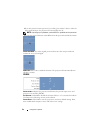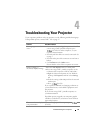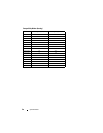
30 Glossary
dB—decibel—A unit used to express relative difference in power or intensity, usually
between two acoustic or electric signals, equal to ten times the common logarithm of
the ratio of the two levels.
Diagonal Screen—A method of measuring the size of a screen or a projected image. It
measures from one corner to the opposite corner. A 9ft high, 12ft wide, screen has a
diagonal of 15ft. This document assumes that the diagonal dimensions are for the
traditional 4:3 ratio of a computer image as per the example above.
DLP
®
—Digital Light Processing — Reflective display technology developed by Texas
Instruments, using small manipulated mirrors. Light passes through a color filter is
sent to the DLP mirrors which arrange the RGB colors into a picture projected onto
screen, also known as DMD.
DMD—Digital Micro-Mirror Device — Each DMD consists of thousands of tilting,
microscopic aluminum alloy mirrors mounted on a hidden yoke.
Focal Length—The distance from the surface of a lens to its focal point.
Frequency— It is the rate of repetition in cycles per seconds of electrical signals.
Measured in Hz (Hertz).
Hz (Hertz)—Unit of frequency.
Keystone Correction—Feature that will correct a projected image with distortion
(wide-top narrow bottom effect) caused by improper projector to screen angle
placement.
Maximum Distance—The distance the projector can throw a usable (bright enough)
image onto the screen in a fully darkened room.
Maximum Image Size—The largest image a projector can throw in a darkened room.
This is usually limited by focal range of the optics.
Minimum Distance—The closest position that a projector can focus an image onto a
screen.
NTSC—National Television Standards Committee. North American standard for
video and broadcasting, with a video format of 525 lines at 30 frames per second.
PAL—Phase Alternating Line. A European broadcast standard for video and
broadcasting, with a video format of 625 lines at 25 frames per second.
RGB—Red, Green, Blue — typically used to describe the separate signals for each of
the three colors.
SECAM—A French and international broadcast standard for video and broadcasting.
Higher resolution than NTSC.
SVGA—Super Video Graphics Array — 800 x 600 pixels count.
SXGA—Super Extended Graphics Array, — 1280 x 1024 pixels count.


















